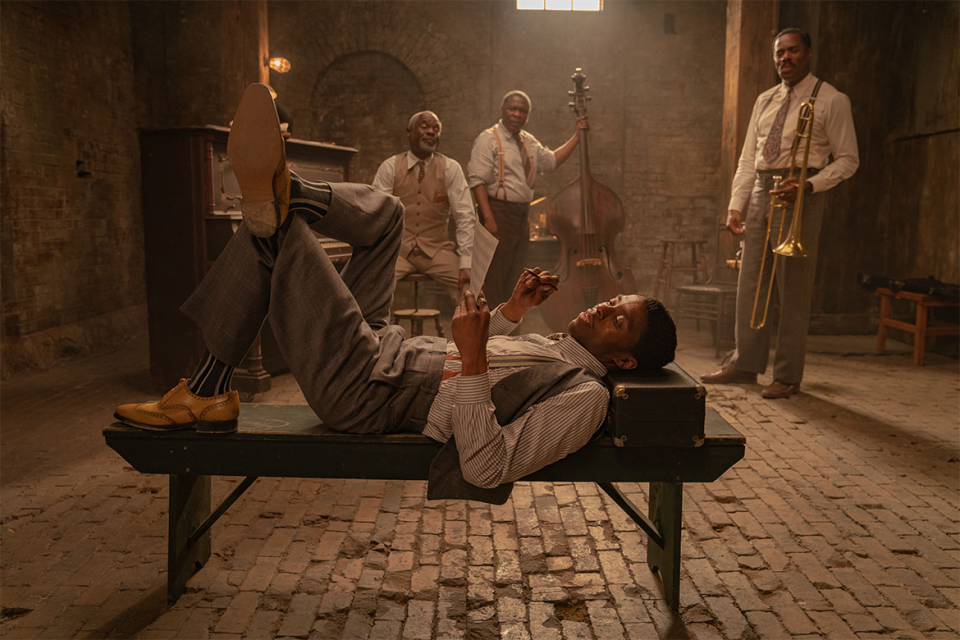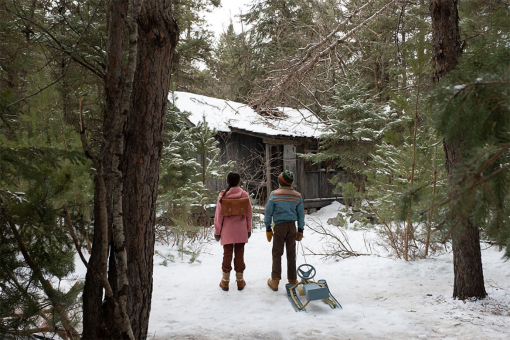Mark Ricker decided not to see a stage production of Ma Rainey's Black Bottom before beginning work on the movie.
"I rather made it a point not to do too much exploration into previous stage productions," the film's production designer explained. "I was given a script, and the script was different (from the stage version). I wanted to react to it. ... I wanted to come into it fresh, so I just dove into the script that I had."
The film stars Viola Davis as Gertrude "Ma" Rainey, the legendary blues singer whose music in the 1920s and '30s earned her the title "Mother of the Blues," and Chadwick Boseman as her fictional trumpet player, Levee, who hopes to break out with his own style of performing.
The movie is based on a 1982 play of the same name by August Wilson and revolves around a Chicago studio session in 1927, where she records the eponymous song, "Ma Rainey's Black Bottom."
The film was released on Netflix in December 2020.
Ricker had the challenging task of creating movie sets that mirrored the dark, claustrophobic space where the musicians recorded and rehearsed, all while evoking their place in the social strata of the time -- the white producer and agent need Rainey and her musicians to make money, but that doesn't mean they view them as equals in the world.
"I looked at it as, what was the real environment that these events would have taken place in?" Ricker said. "There was never a discussion of having this feel theatrical. Any feeling of that is probably inherent to the dialogue, and the speech patterns."
The movie spends almost all of its time in the recording studio and a basement-level rehearsal space. Only occasionally do the characters appear elsewhere -- on the street outside or, in a brief opening montage, a variety of stages where Rainey and her band performed.
"I really did think about the fact that the majority of this film would take place in these confined rooms, these limited spaces," Ricker said. "So I wanted to create spaces that would hold up for the amount of time that the audience spent in them. In every corner and every direction we tried to create interesting frames, with interesting textures."
According to publicity materials for the film, Ricker designed the sets "with tone and performance in mind." For instance, the small, windowless room where band members rehearse appears to get hotter as the day goes on, and with it the tempers of the band. The room also features a locked door that, ultimately, leads nowhere - a tidy allegory representing Levee's unattainable dreams and goals for his future.
Ricker said there were challenges in creating the overall look of the film, from the white working-class industrial neighborhood where the studio was situated (set in Chicago, although filmed in Pittsburgh) to the opening montage of performance set pieces from Rainey's tour.
"Some of it is deliberate, some of it is just instinct and gut. Some of it happens organically, through the research," Ricker said.
"There was a deliberate notion of, when you're on the street where the accident happens, there were a lot of shops, a lot of signage, a lot of words. The sun is beating down on them. The second you step off that street and go down the alleyway, it gets darker. There was a distinct line. The second you stepped off the street, the look changed.
"There was a lot of visual stuff smacking against each other, introducing the world before you get to that alleyway. It sort of worked as a funnel."
Once inside, however, Ricker didn't want the set to distract from the script.
"I wanted it to support the words, the theme, the actors - it was all about their faces, watching their faces," he explained. "I wanted there to be texture and interesting spaces, so they weren't just against a plain wall, but I didn't want it to be distracting."
The studio, where most of the movie takes place, was an interesting dichotomy of new, cutting-edge technology (for the time) nestled into an old, post-industrial setting.
"The recording technology simply didn't exist until the years we were representing in the film," Ricker said. Director George C. Wolfe and he "decided it would be in the corner of an old factory. We were really trying to be true to what those environments would be."
The claustrophobic nature of the set was an illusion, he noted. Although the basement space appears cramped, it actually opened in all directions so filmmakers could position their cameras and lights, and play with the darkness.
The recording studio is more spacious, but the office window that looks down on it - and from which the producer and agent look down on Rainey and her band - is symbolic of their place in society, Ricker said.
When it was a factory, he said, it was the room where the manager "could look down on the workers." And while Rainey is recording, he noted, "the only people who go up those stairs and are at the highest point in the movie are the two white people."
Ricker built the studio in a 19th-century steel mill, and he soundproofed the room with period-correct materials, such as horse hair, burlap and bricks - all of which added texture to the scene.
Still, he hopes the set was largely unobtrusive.
"I wasn't trying to be theatrical in any way," he said. "I wanted it to be rooted in a gritty authenticity. So, when the actors were there, you paid attention to them."
Ultimately, he said, the audience should have "an emotional reaction to the words" and not be focused on the setting.
"With Ma that really happened because of the brilliance of the words," he said. "It wasn't an epic production, but it was epic in its themes. I wanted to create a world where that could be epic."
Some of the most powerful lines in the dialogue are uttered by Boseman's character, Levee, whose musical acumen and bravado mask a lot of uncertainty and hidden pain.
Boseman died not long before the movie's release. The actor, whose leading roles ranged from Jackie Robinson in 42 and Thurgood Marshall in Marshall to Thoth in Gods of Egypt and the Black Panther in several movies in the Marvel Cinematic Universe, had been battling colon cancer for four years, and he kept quiet about the seriousness of his condition during filming.
"He was particularly private on this," said Ricker, who had worked with him previously on 2014's James Brown biopic Get on Up.
"I recognized that this was a demanding role for him, he was putting everything into it, and we chatted about that for a bit," he recalled. "It was obviously devastating. It was beyond comprehension for some time. He was in a zone, and now that zone becomes clear."
Boseman was thinner than Ricker had known him to be in the past, but he "assumed he had lost the weight for the role."
"In hindsight, yes, things make sense. In the middle of it? Not any indication," he said. "He was just in the zone. He was just so focused on what he was doing."
Ricker said he worked closely with Wolfe, the director, and cinematographer Tobias Schliessler, who was responsible for the camera and lighting crews, to create a distinctive look for Ma Rainey.
Schliessler, he said, "came late to the process," but Ricker said he did "a brilliant job" with lighting the sets and creating the blue-gray palette that shadows the film.
For instance, Ricker said he and Wolfe disagreed about having a window in the basement. The director, he said, "was adamant" it should be a windowless room, as it was described in the script.
"But if there was no window, it would have to be lit by lightbulbs, and that wasn't going to do," Ricker said. "We were able to convince George to put this one small high window up in the space. We were able to use that light. And once we got that window, everything changed."
In fact, he said, August Wilson's widow, Constanza Romero, was an executive producer on the film, and after seeing the film in progress she told Ricker, "it's all about that window."
"It was a bit of a triumph," he said.
Ricker says the job of production designer is perfectly suited to his talents, but it's not a career he'd dreamed of when he was younger.
"I've always loved movies, from when I was a kid," he said. "Back then, I didn't realize there even was an art department."
But the job, he said, "combines all of the things that were of interest to me growing up: photography, architecture, history. I couldn't do any of that as a profession, but I can cobble it together and take from it what I need to do what I do."
It's not easy to describe his process, he admitted.
"When you're doing it, you're thinking about it, but it's hard to describe that process because you're just doing it. The material presents itself to you in different ways. It's like when you're reading a book and the images are in your mind. You're not thinking about it, they're just there."
"Everything is its own child," he added. "You just try to nurture it and bring it up so it can live a good life."
He wouldn't want to be doing anything else, he said.
"It's a great job. A challenging job," Ricker said. "There's something that makes people who are in the art department want to be in the art department. It's all about creating that world. I love collaborating with directors and figuring out what serves the film."
He used to love doing it on stage, too, where Ricker said he got his start.
Which reminds him, he still is curious how the stage production of Ma Rainey differed from the movie.
"I still haven't read the play," he said, a little ruefully. "But I am interested in picking it up and reading it, after the fact."
For now, Ricker is taking his time, looking for the next right project.
"I just finished, right before Christmas, a limited series based on Halston, the fashion designer, for Netflix," he said. "It was a vastly different era and subject matter than I had done before. I feel like my last four projects couldn't have been more different. I like trying to mix it up."
Now, he said, "I'm reading scripts."















